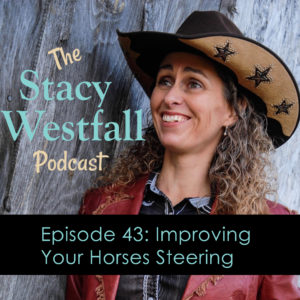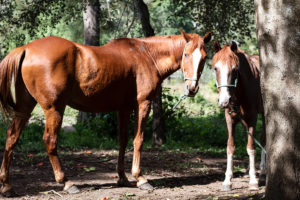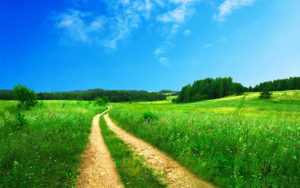Episode 43: Improving Your Horses Steering

“Horses don't always follow their heads, but they do always follow their shoulders.” Stacy Westfall Click To Tweet
Have you ever been trail riding and realized that your right leg was passing very close to a tree? Have you pulled the reins to the left, and the horses neck went to the left but your leg still hit the tree? This is because horses don’t always follow their necks. They follow their shoulders.
Most of us have learned that if we want the horse to go to the right, we pull on the right rein and if we want the horse to go to the left, we pull on the left rein. Most of the time, the head and shoulder will go in that direction.
In this episode, I’m going to explain the foundation for improving steering. This involves becoming very aware of shoulder control. I’ll explain the idea that horses don’t always follow their heads, and I’ll give you an exercise to help improve your timing with this new awareness.
“When you realize how much can be taught on accident, you can really follow the line of thinking and start seeing how the horse is applying this.” Stacy Westfall Click To TweetShow Notes:
[03:46] Horses don’t always follow their heads, but they do always follow their shoulders.
[04:21] It’s easy to think horses follow their heads, because that’s one of the first things that riders and horses are taught.
[04:36] Today, we’re going to embrace the idea that the horse doesn’t always follow the shoulder, and we can move the head in one direction and the shoulder in the opposite direction.
[04:44] The only way this is possible is if the horse comprehends it and the aids are applied in the right manner.
[04:58] The same method that was used to train the horse to follow the shoulders, can have different timing and make something different happen. You can look at this as untraining or adding another layer.

[05:27] When I coach riders with horses at the elementary level, I often see steering problems.
[06:04] If a horse lacks a higher education, a rider might release out of self-preservation and the horse starts to see Grandma’s rules and does what it wants.
[07:46] It’s very fascinating what we can teach these horses on accident. When you realize how much can be taught on accident, you can really follow the line of thinking and start seeing how the horse is applying this.
[08:41] Sometimes riders don’t notice subtle steering problems, because they don’t ride specific patterns.
[11:34] Arena work helps horses see a pattern and think logically.

[14:39] Spiraling out is the horse bending to the left and going to the left. The right rein gets pulled towards three o’clock and the shoulder goes to the right.
[15:29] In neck reining, the right rein means to go to the left. This sounds confusing, but we are still moving the horses shoulder to the left. It’s about the shoulders.
[15:56] Go in a small circle to the left. Your horse is going to ask a lot of questions.
[17:50] Whatever you release on is going to matter.
[18:31] Pay attention to the front feet. Think about where they are going. This will change every three or four steps.
[19:32] You can start to feel where you can have the timing to influence the horse.

[21:39] In elementary school, we teach the horse to move their shoulder in the direction that we pull the rein.
[21:57] In high school, we spiral out and ask the horse to bend in one direction and move the shoulder in the opposite.
[22:21] Eventually, we get to a point where we can neck rein. This means the horse will move the shoulder and bend to the direction of travel.
[22:47] The first exercise is one rein and both legs evenly. Ride in a circle to the left. Using one rein, the rider starts to experiment after a while.
[25:18] Riders start to realize how effective their legs can be for driving the horse forward and in a bigger circle.
“Subtle nuances are more obvious when you're riding a pattern in an arena than they are out on the trail.” Stacy Westfall Click To Tweet
Links and Resources:
Equithrive Use the code STACY for 10% off
Tennessee Equine Hospital Facebook
Episode 38: Rewarding Physical and Mental Changes in Your Horse
Episode 18: Improving Your Aids When Riding Your Horse
Episode 19: Your Weakest Aid When Horseback Riding
Episode 20: The Hierarchy of the Riders Aids as the Horse Advances
Episode 36: 3 Reasons to Do Groundwork With Your Horse
Have you ever wondered what a live version of this podcast would be like?I’m hosting some live, online video calls that are like a live version of this podcast. I teach on a subject, answer questions and for those who are brave, I’ll turn your video on live too and you can join me for a conversation!
If you want to learn more about this you can visit https://stacywestfall.com/live/ for more information!
9 Comments
Leave a Comment
SUBSCRIBE TO THE PODCAST HERE:





YOURS FREE
WHY IS MY HORSE...?




This exercise was a game-changer for me and my older, broke horse. Really got us back to the basics by simplifying our communication. After 3 days, 10mins each direction, my horse is so much softer to the rein aid now. It worked much better for us than the stationary neck flexing exercises promoted elsewhere.
so I tried this today with my 9 year old gelding who is still green with steering. I must say how frustrated I got. He kept going in tiny circles…I tried to speed him up etc and it didn’t work. I came home and relisten to the podcast and next time I will try to work more with my inside rein and repositioning it to see if this makes a difference. I will also pay more attention to his front feet as well. Can’t wait to hear more strategies on how to get a “more whoa” type of horse to transition from walk to job and then jog to canter easier. Thanks for all your ideas.
You could also watch a few of the early episodes of Stacy’s Video Diary: Jac on my YouTube channel. If you watch the videos with the early rides, this is the method I use the most early on. Maybe the visual will help too!
This might be an episode early…but it is hard to say where to start if you don’t start from the beginning as it all builds to the next step: https://youtu.be/Dtwob-V6aF0
I love this exercise using only the left rein for a left circle, leaving my legs in one position.
It’s fun to have a simple way to do something!
We can always make it more complicated…but simple is good too!
I tried this exercise at home last night. About 10 minutes in each direction. It was amazing! So simple. It really does teach ‘feel.’ I’m glad you noted when you started to see changes in a rider. I suspect I never work an exercise long enough.
I wasn’t sure when to stop, so I settled for improvement on a first try (not perfection). Once I get this going well, what’s next?!
I think you will find Episode 44 is a great complement to Episode 43. I interview Bob and his progress. I think his view will give you more insights on where to go next! Great job putting things into action!
Thank You! I’m understanding the technique a lot more because of you.
You are welcome! Thanks for listening!